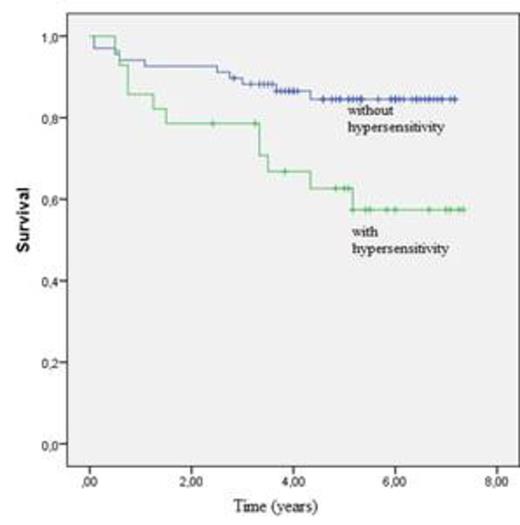Abstract
Background
Acute lymphoblastic leukemia (ALL) remains the most common pediatric malignancy in the world. Overall survival rates have increased from 30% in the 1960s to 90% in past 10 years. Enabling this dramatic improvement are the multi-agent chemotherapeutic regimens in which asparaginase is cornerstone. Unfortunately, hypersensitivity to asparaginase has been a commonly-reported adverse event, associated with inferior outcomes in ALL.
Methods
Between January 1, 2005 and December 31, 2012, 97 patients were enrolled in the study. Selection criteria included those were diagnosed with ALL and given the ALL-BFM-2000 protocol at Dr. Behcet Uz Children's Hospital. Data regarding age at diagnosis, sex, follow-up duration, hypersensitivity of L- asparaginase, status of relapse and outcome were gathered from the patients’ files. The event-free survival (EFS) and the overall survival (OS) of the patients who developed and did not develop hypersensitivity to L- asparaginase were compared. Peg-asparaginase was given to patients who developed L- asparaginase hypersensitivity, and erwinia asparaginase was given if the patients developed peg-asparaginase. The asparaginase activity could not be measured. Kaplan mayer test was used to calculate the EFS and the OS.
Results
A total of 97 patients were evaluated. Thirty-two were standard risk, 49 were moderate risk, and 15 were high risk. 61 patients were male, and 36 were female. The median age (range) at diagnosis was 5 (1-15) years. Median (range) follow-up duration was 5.1 (0.08-7.3) years. Of the 97 patients, 28 (29.2%) developed L-asparaginase hypersensitivity. The event-free survival was 84.5 ± 4.6%, and 62.6 ± 9.4% for patients who developed and did not develop hypersensitivity, respectively (p=0.01). The overall survival rates were 89.2 ± 3.9 % and 74.6 ± 8.3% for patients who developed and did not develop hypersensitivity, respectively (p=0,07).
Event-free survival. The five years EFS±SE for the patients who developed and did not develop native L- asparaginasehypersensitivity were 84.5 ± 4.6% and 62.6 ± 9.4%, respectively (p=0.01).
Event-free survival. The five years EFS±SE for the patients who developed and did not develop native L- asparaginasehypersensitivity were 84.5 ± 4.6% and 62.6 ± 9.4%, respectively (p=0.01).
Conclusions
This study demonstrated that EFS was lower in patients with L-asparaginase hypersensitivity than those without hypersensitivity, although there were no differences in terms of OS. All of the patients with hypersensitivity received a sufficient dose of peg-asparaginase or erwinia asparaginase according to the ALL-BFM-2000 protocol. The lower EFS for patients who were switched to peg-asparaginase because of L- asparaginase may be explained by silent inactivation of peg-asparaginase. If the activity of asparaginase could not be measured, it could be preferable to switch to erwinia asparaginase.
No relevant conflicts of interest to declare.
Author notes
Asterisk with author names denotes non-ASH members.


This feature is available to Subscribers Only
Sign In or Create an Account Close Modal